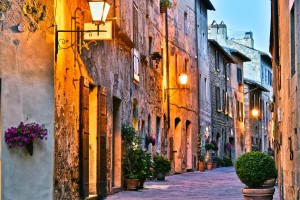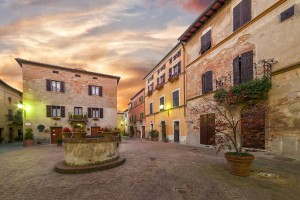How does a town become an ideal town? Opinions differ greatly on this matter and changed just as much over the course of centuries. The Renaissance and humanism most certainly left a massive mark on this discourse, and that’s something you can both see and experience when visiting Pienza. This architectural and rational marvel with Piazza Comunale serving as its urban hub is truly extraordinary, particularly for a small town. Pienza’s historic centre was even declared UNESCO World Heritage Site in 1996 and should be an absolute must-visit for your next trip to Tuscany.
Time to build an ideal town

©Bigstock.com/monticello
For the longest time Pienza in Val d’Orcia, a UNESCO World Heritage Site in its own right, flew under the radar. The village was originally called Corsignano. Its first documentary evidence dates back to the 9th century, but things only turned interesting after parts of it became property of the Piccolomini family. Aeneas Silvius Piccolomini was born here in 1405. This name might not ring a bell, but he would eventually become Pope Pius II many years later. He had Corsignano rebuilt into an ideal town starting in 1459 and even named it after himself: Pienza.
This intended retreat from Rome created a trend that was quickly adopted by other Italian towns before taking Europe by storm. In a somewhat ironic twist, Pienza’s full urban planning concept was never put into effect. Florentine architect Bernardo Rossellino, a student of Leon Battista Alberti, completed the main buildings and structures within three years, but the pope’s death in 1464 prevented further extensions and developments. Still, the historic centre of the city of Pienza is a genuine gem even without this potentially crowning finale.
All roads lead to the piazza

©Bigstock.com/firewings
The airy, centralised design of Pienza’s historic centre became the model for numerous Italian towns. Roads lead to Piazza Comunale, the main square of the humanistic ideal town, from all directions. Every spot, every place on the piazza reveals appealing, completely new perspectives on the four main buildings, perfectly complemented by the almost magical scenery of the Val d’Orcia. The travertine fountain with the Piccolomini family crest, a model for numerous Tuscan fountains in its own right, emphasises the intended asymmetry of the square and adds yet another, highly special dimension to its unique look and atmosphere.
Santa Maria Assunta
Four ideal town buildings flank Piazza Comunale, and the Cathedral of Pienza certainly is the most important specimen of the grand architectural arts. Santa Maria Assunta, to give the co-cathedral its full name, was built as a three-nave hall church from 1459 to 1462. Even though the façade clearly is a Renaissance brainchild, a lot of the cathedral was heavily influenced by the northern-alpine Gothic style, likely due to papal visits to German-speaking countries. A lot of the façade is geared toward the Tuscan order and rural region architecture, e.g. the entrances with their overarching side arches, the four colossal pilasters and the aedicula alcoves. Comparisons to Santa Maria Novella in Florence and Tempio Malatestiano in Rimini by Leon Battista Alberti are fairly obvious as Rossellino was heavily influenced by his teacher.
All basic ingredients of the Renaissance await you inside the cathedral, colliding rather charmingly with Gothic elements. Rossellino only knew very little about the strict architectural rules of the Gothic period. The odd capitals on the bundle pillars, the imposts below the groined vaults and the slightly misaligned placement of the lateral secondary choir chapels speak volumes. Add the modern, electric organ and the classic Gothic paintings by Sienese artists into the mix and you get an equally monumental and unusual religious building that will wow you.
Other World Heritage highlights in Pienza
It should go without saying that the massive tremendous cathedral is widely regarded as the peak experience of your Pienza tour, but it’s far from the only highlight on Piazza Comunale. Another three buildings flank the centre of the town planning ideal, and you shouldn’t sleep on those either:
- Palazzo Pubblico: Corsignano needed its own town hall when it became a town in order to maintain this status. As such, the palace was more for show than anything else. Experts believe that Rossellino wanted this free-standing building to become a sort of mediator between the religious cathedral area and the secular market square. Additionally, he consciously kept the town hall’s belfry shorter than the cathedral’s to maintain its status.
- Palazzo Piccolomini: Leon Battista Alberti didn’t only inspire Rossellino’s cathedral. Palazzo Piccolomini is clearly based on the teacher’s Palazzo Rucellai in Florence. Ranging from the rectangular layout to the cleverly placed family crests and apostolic letterings around the windows to the rock façade itself, you might see some familiar features. The small, rectangular courtyard with its garden and the arcade, however, meets Renaissance ideals. Enjoy the gorgeous view of Val d’Orcia and Pope Pius’ beloved Monte Amiata from the loggia on the south-facing back of the palace.
- Palazzo Vescovile: Extended papal plans envisioned additional palaces built by various cardinals. As you already know, these plans remained just that due to Pius’ death leaving Palazzo Vescovile as the only memento, if you will. Financed by Cardinal Rodrigo Borgia, the future Pope Alexander VI, it was intended to accommodate the bishops visiting Pius II in Pienza. It currently houses the Diocesan Museum and the Museo della Cattedrale. You get to see religious artefacts, paintings and the 12th to 15th century and regional textile works.
It’s hard to imagine what the historic centre of Pienza could have looked like as Piazza Comunale with its four impressive buildings is a breathtaking must-see experience already. The ostentatious cathedral with its stylistic plurality and monumental dimensions plus the three highly different yet harmoniously imbedded palaces emphasise the humanistic ideal of Renaissance town planning in a complex, multifaceted manner. Don’t miss out on Pienza with the adjacent Val d’Orcia and get to experience two UNESCO World Heritage Sites at once!